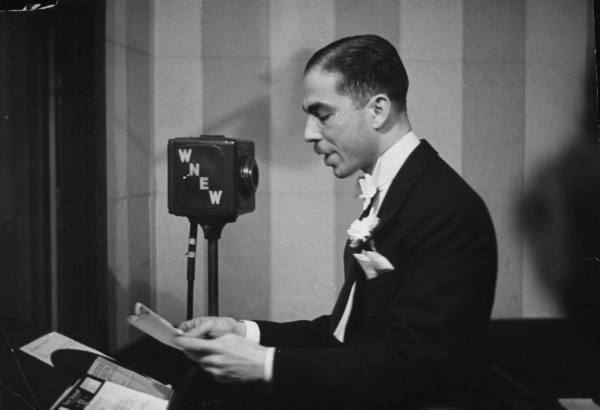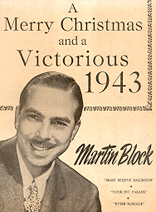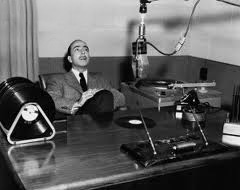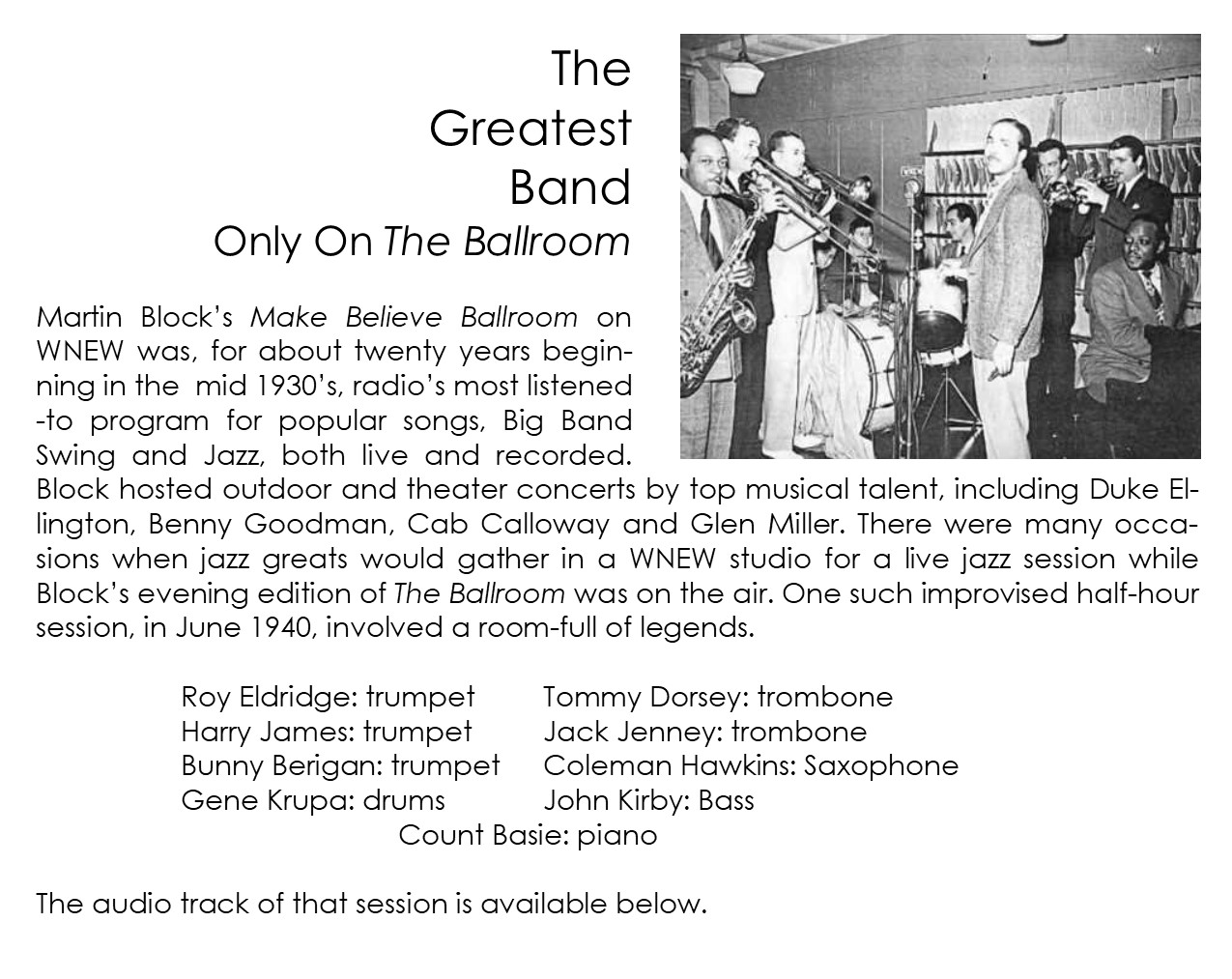WNEW Station Manager Bernice Judis comments on her meeting and hiring Martin Block in 1935. William B. Williams reports on a Martin Block on-air appearance with Glenn Miller. Audio from Westinghouse LP “First Fifty Years of Broadcasting.” and from “The Home Front.” WWII documentary.
Audio PlayerThe Future of Radio
New Yorks Daily News 3/17/04
By DAVID HINCKLEY

As the only station broadcasting from inside the New Jersey courtroom where Bruno Richard Hauptmann was on trial for the kidnapping and murder of Charles A. Lindbergh’s infant son, New York radio station WNEW had itself a huge coup. It also had a problem.
WNEW’s on-site reporter and engineer were not set up to carry play-by-play coverage of the trial, only periodic bulletins. But because public interest was so high, WNEW didn’t want to switch to, say, an orchestral remote that would prevent the station from using its logistical advantage to break in with each shard of news.
A month or so after the trial began in January 1935, a solution to this dilemma was proposed by a low-level employee named Martin Block, a good-natured, ambitious fellow with slicked-back hair and a pencil-thin mustache in the sophisticated style of the mid-’30s.
Block was the warm body sitting at the microphone back in the WNEW studios at 501 Madison Ave., and his suggestion to WNEW general manager Bernice Judis was that he fill the downtime by playing records.

Something that, in early 1935, respectable radio stations hardly ever did. For a station like WNEW prided itself on live music. Records were lazy and redundant. If a listener wanted a record, he or she would buy it, not turn on the radio.
Ironically, many artists felt the same way for exactly the opposite reason. They were afraid that if fans could hear their recordings on the radio, those fans would not buy records any more.
But Block persisted, and on Feb. 3, Judis told this $25-a-week part-time staff announcer pest to go ahead and do it. Block faced one final hurdle, which was that WNEW didn’t own any records. So he trotted out to the nearest Liberty Record Shop and bought five of them, all by Clyde McCoy. He also launched his plan, which basically was to demonstrate that records were the future of radio.
 Block, A New York kid who was born to sell, had started his career peddling razor blades and potato peelers off a sound truck on Broadway. By the early 1930s, he had moved to the West Coast, where he got his first radio job with a two-bit outfit in Tijuana and then worked his way up to Los Angeles. One of the big shots in L.A. then was Al Jarvis of KFWB, who played records regularly and around 1932 began calling part of his show “The World’s Biggest Make-Believe Ballroom.” He would play several records in a row by the same artist while painting a picture for his listeners of this music wafting over a sparkling dance floor.
Block, A New York kid who was born to sell, had started his career peddling razor blades and potato peelers off a sound truck on Broadway. By the early 1930s, he had moved to the West Coast, where he got his first radio job with a two-bit outfit in Tijuana and then worked his way up to Los Angeles. One of the big shots in L.A. then was Al Jarvis of KFWB, who played records regularly and around 1932 began calling part of his show “The World’s Biggest Make-Believe Ballroom.” He would play several records in a row by the same artist while painting a picture for his listeners of this music wafting over a sparkling dance floor.
Now, three years later, Block envisioned crafting his WNEW show on the same model, and that was fine with Judis. The problem was the sales staff, which told him no sponsor would buy time for a program of prerecorded music. So Block went out and found his own sponsor: the makers of Retardo pills, a harmless if useless weight loss gimmick that sold for $1 a box. “Ladies,” Block would purr into the microphone, “be fair to your husband by taking the reducing pill.”
A week later Block and WNEW claimed Retardo had received 3,750 responses, and soon enough there was little doubt the show was a hit. Within a few years, “The Make-Believe Ballroom” commanded a remarkable 25% of the radio audience. Block became friends with stars like Glenn Miller, who needed him to play their records, and for his sponsors he claimed to have invented two of the most popular cigarette slogans ever: “ABC: Always Buy Chesterfield” and “LS/MFT,” for “Lucky Strike Means Fine Tobacco.”
The first theme of “Make-Believe Ballroom,” naturally, was a Clyde McCoy number, “Sugar Blues.” That was bumped by Charlie Barnett’s “Make-Believe Ballroom,” which in turn yielded to Miller’s “It’s Make-Believe Ballroom Time.” Block co-wrote the lyrics to that one and, after Miller was killed in a plane crash in December 1944, Block announced that “Make-Believe Ballroom Time” would remain the theme forever.
 “Make-Believe Ballroom” went into national syndication in 1940, and by the end of World War II, Martin Block was making $22,000 a week. Then, in August 1946, KFWB announced that Block was coming west to take over the show there. Almost a year of headlines later, in June 1947, he did. And he promptly tripped over his shoelaces.
“Make-Believe Ballroom” went into national syndication in 1940, and by the end of World War II, Martin Block was making $22,000 a week. Then, in August 1946, KFWB announced that Block was coming west to take over the show there. Almost a year of headlines later, in June 1947, he did. And he promptly tripped over his shoelaces.
Angelenos considered him an obnoxious, arrogant, know-it-all New Yorker and tuned him out by the millions. By the fall of ’48 he was ready to return to New York, to take advantage of the new television opportunities. He tried to. But he was not a TV guy, and soon he was back at WNEW. In 1954, he jumped to ABC radio and, when the tidal wave of rock ‘n’ roll crashed onto the shore, he jumped to WOR, where he did weekend shows until his death in 1967. WNEW continued the “Make-Believe Ballroom” with a string of other hosts. Descendant programs are heard to this day.

While Martin Block may have felt his real calling was to sell diet pills and Edwin cigars, many radio people feel he was to radio what Bing Crosby was to recording: the first to introduce an intimate, personal style rather than a disembodied voice of authority.
Whatever his legacy, the Make-Believe Ballroom was the best dance value in town.
Photos added by WNEW1130
Make Believe Ballroom Time-Glenn Miller, The Modernaires
Audio Player
First, There Was Al Jarvis



Hello, Mr Biel – You’re right on both counts. Al Jarvis played recordings on the air in LA before Martin Block did in NY. (Some recordings, in fact, were being played and announced on the BBC in the late 1920’s) Block is often credited with being the first disc jockey because he was the first DJ to become nationally famous and may have been the first broadcast personality to actually be called a “disc jockey.” That’s what Walter Winchell called him. But we have removed the headline about Block being the “first DJ.” Also, concerning your comment that the Martin Block story was wrong in stating that WNEW’s reports originated inside the courtroom where Bruno Hauptman was tried in the Lindbergh kidnapping case, you’re right again. A WNEW reporter was inside the Flemington, NJ courtroom to cover the trial but had to leave the room and go to a men’s restroom where his engineer had set up their broadcast equipment. So, their broadcast reports were transmitted from inside the courthouse, not inside the courtroom. The second paragraph makes that clear, but use of the word courtroom instead of courthouse in the first paragraph is incorrect. Thanks for visiting our site.
That probably would have been Ted Brown, who sometimes did WNEW programs with his wife as Ted Brown and the Redhead. But there is a lot wrong with this article. It details that Al Jarvis had been doing a program for three years on KFWB before Block started on WNEW — so how could Block have been “The First DJ” as proclaimed by the headline. And WNEW did not do broadcasts from inside the Hauptman courtroom, they were outside, thus could only do occasional updates as stated in the article. There is a BIG difference.
I remember it well. I also remember a program that professed to precede Block at some point in his New York career, ergo the lyrics… “Am I blue? No I’m Brown. Got a smile on my face not a frown. Every night, five o’clock, I go on just before Martin Block.”
Does anyone know what program that was?
Thanks.